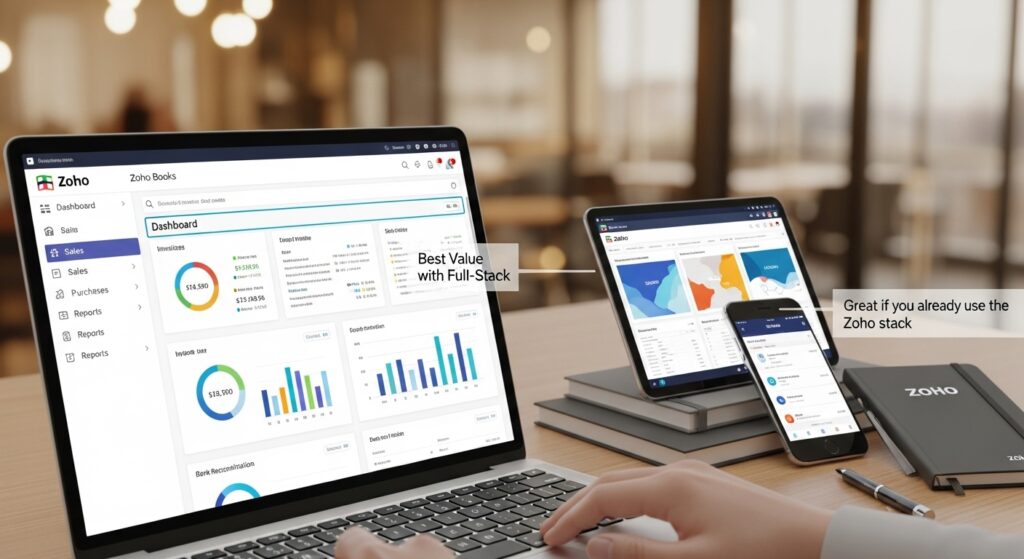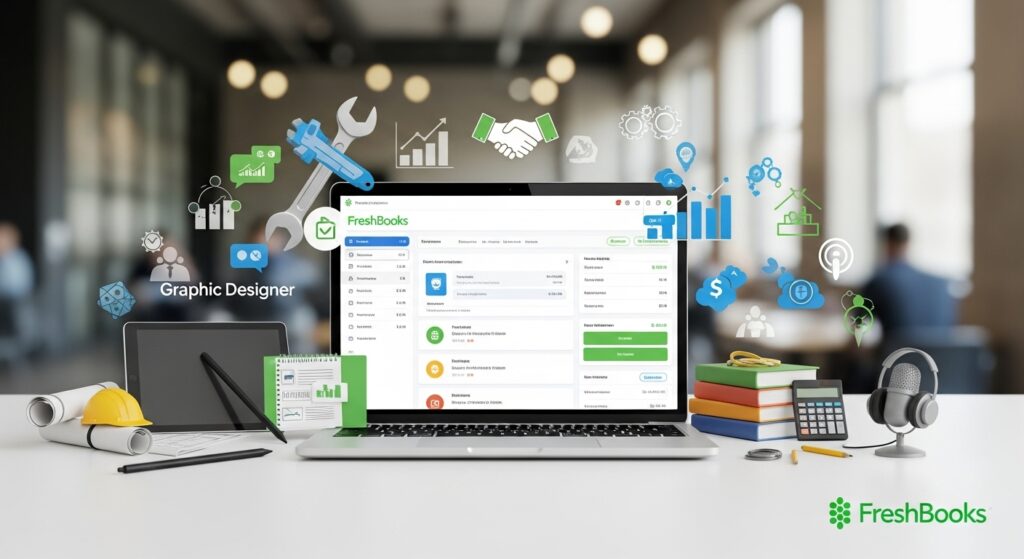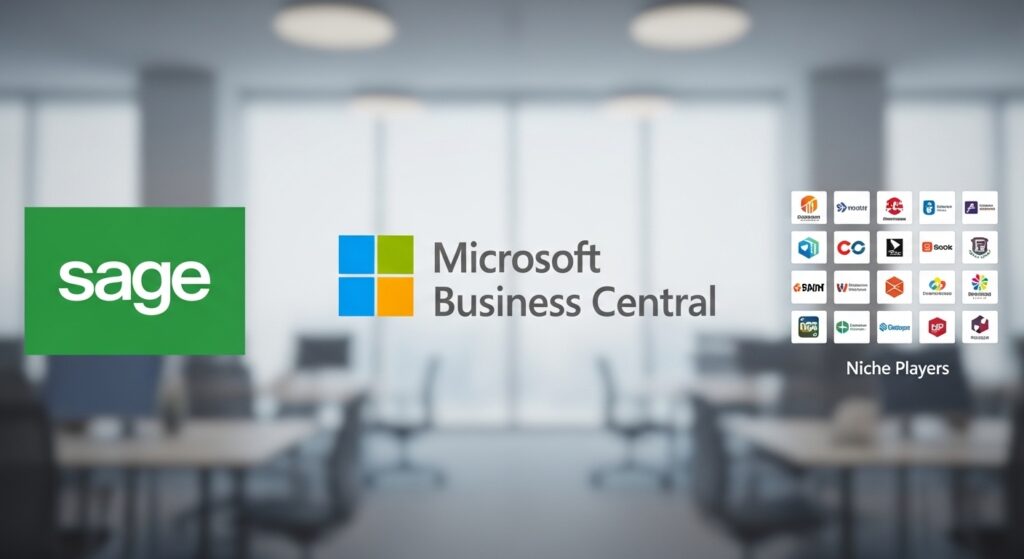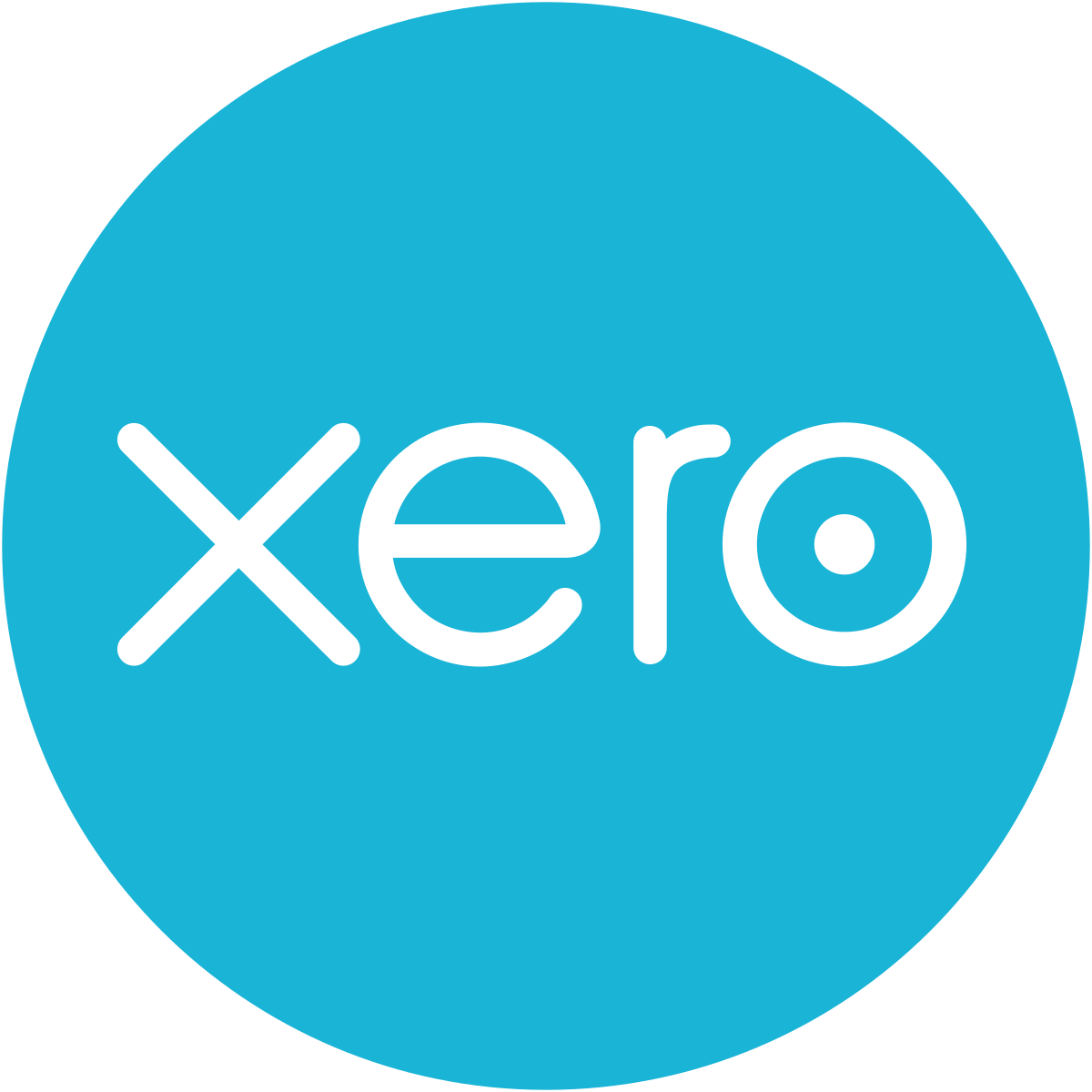No BS. This is the checklist you actually want to choose accounting software that won’t slow you down, cost you dear, or blow up at tax time. And I’ll take you through what matters in the year 2025, how the big players compare, and the steps to choose, migrate and get locked in with software that works for your business.

The short and sweet (read it and act)
You’ll decide on software by considering three things: your workflow, your integration needs, and how much you are willing to pay for convenience. If you want a quick answer:
| Business Type / Need | Best Fit Software | Source(s) |
|---|---|---|
| Big general small business needs | QuickBooks en línea | Investopedia, QuickBooks |
| Growing small business with international / multi-user needs | Xero | Xero |
| Tight budget or heavy CRM/stack needs | Libros Zoho | Zoho, Tech.co |
Now read the whole thing. It’s explains why those answers exist, what to look out for in 2025 and how to move without wrecking payroll or losing receipts.
Why does it matter what accounting software you choose (still)
This is not just bookkeeping! Your accounting system is the backbone for things like cash flow, tax compliance, payroll, pricing decisions, and investor cred. If you choose poorly you’ll spend countless hours on reconciliation, and dollars fixing errors, and it can affect your decision-making based on bad data. If you choose well you’ll get automated reconciliations, faster invoicing, cleaner tax prep, and you’ll have the space to operate the business.
What changed in 2025 (Look out for)
is automation and consolidation. Marketers are promoting features that remove the “manual” from bookkeeping: smarter bank reconciliation, auto-categorization, and payment/receivables (BNPL, instant payouts) native to the product. Pricing has also crept up; QuickBooks and others changed plans in 2025 – keep that in mind for budgeting.
QuickBooks
Xero
Expect more embedded payments and cash-flow tools embedded into accounting platforms — they provide less integration but greater vendor lock-in.. again, this will continue to grow. Xero just keeps doing more payments and late-payment solutions with their partners.
The Australian
The only decision criteria that matter – use this checklist
I won’t give you a feature soup. Use these seven filters, and in that order.
Core bookkeeping needs
Invoicing, bank feeds, automated reconciliation, chart of accounts, trial balance, basic inventory (if you stock goods) are the baseline.
Payroll and compliance
Are you doing payroll – how complicated? (multi-state, contractors, benefits deposits)? Payroll features, or integrations will be much more important than bells for most small businesses.
Integrations and stack fit
Will it integrate easily with your point-of-sale, ecommerce (Shopify, WooCommerce), CRM and tax software – how many third-party connections do you need?
Reporting and accountant access
Can your accountant login? Is it easy to extract financial statements and trial balances? Do reports export to Excel cleanly?
Multi user and permissions
Do you need role based access, audit trails and user caps? Pricing and the true cost
Look for not just the headline plan but also transaction fees, payroll add-ons, user seats, etc. Expect 2025 pricing changes from many vendors and plan for increases in your budget.
QuickBooks
Xero
Data ownership and exportability
Can you get a complete copy of your data? Is there a backup? If you leave, can you have a usable dataset?
These filters are useful in scoring each vendor you consider. If a product does not work well for core bookkeeping, drop it.
Short vendor overview (the basics for 2025)
I’ll give you a summary of the major contenders and what type of business they are best suited for. These are practical notes and not feature lists.
QuickBooks Online — best value overall for a lot of small businesses

Why it is selected: lot of the features in the application, huge ecosystem of partners, accountants are familiar with it. QuickBooks is focusing on automation of tasks, payroll and integrations. Expect ongoing changes to pricing and plans in 2025, budget accordingly.
Investopedia
QuickBooks
Mejor para: businesses that want a full accounting tool with payroll, payments and extended app ecosystem (retail with POS, service businesses, agencies).
Watch for: pricing complexity and the cost of add-on payroll and advanced reporting.
Xero — clean small-business accounting with excellent multi-user flow

Why it is selected: modern user experience, outstanding bank reconciliation tools, easy collaboration features for accountants, and an ecosystem to push cash-flow tools and payment tools. Xero is continually implementing integrations that are reduce manual work, helping small businesses in the growth stage.
Xero
Best for: with clean reports, growing small businesses that need simple access for multiple users and strong reconciliation steps are best for.
Watch for: limits on users/features by plan, and increases in pricing of plans in 2025 year.
Zoho Books — best value with full-stack, great if you already use the Zoho stack

Why it is selected: value prices for the use, flexible plans, integrate well with the rest of the Zoho stack (CRM, Projects, Inventory). For business already in the Zoho space/stack, with Zoho these tend to be the cheapest paths to a full ecosystem.
Zoho
Tech.co
Mejor para: solopreneurs, small service firms, businesses who are all in with Zoho.
Watch for: if you implement Zoho and then leave it, the downside is ecosystem lock-in.
FreshBooks — service firms and freelancers

Why it is selected: impressive time-tracking, easy invoicing with clients, and other features that match well with service providers. Superbly easy to operate while doing simple accounting with rates billed to clients and invoicing.
Mejor para: freelancers, consultants, and agencies that bill by the hour and want, want the most polished invoices.
Watch for: FreshBooks inventory features are less robust and reporting is not as powerful as QuickBooks and Xero.
Wave — free for the basics, paid for payroll and payments

Why it is selected: truly free accounting and invoicing for small companies; you pay for payments, and payroll. If you are looking to account and invoice in one place without engaging advanced features, this will save you a lot of money.
Mejor para: micro businesses, solo freelancers, and side hustles.
Watch for: limitations on support and scaling.
Sage, Microsoft Business Central, and niche players
These are better for businesses moving into ERP mode or needing industry-specific features. They may be too much for many small business, but are right if you have complicated inventory or manufacturing.

How to score vendors for your business (simple matrix)
Establish a 0-5 score for each vendor in the following categories:
- Core bookkeeping (0 – 5)
- Payroll (0 – 5)
- Integrations (0 – 5)
- Reporting & accountant access (0 – 5)
- Cost (0 – 5, including your best guess of the 12 month cost)
- Data portability & security (0 – 5)
Weight them according to importance. For example, if payroll is worth 40% of your decision, simply multiply the score of the vendor for payroll score, by .4. Then take the vendor wherever your scores weigh out in favor may be your answer. I recommend doing your scoring quarterly at least for the first year; don’t get too complicated with this. You should be able to knock off losers quickly.
Price realities in 2025
Subscription creep has happened to us. Vendors announced updates in price, in 2025 for QuickBooks and Xero, announcement of updates for all plans. This means that price benchmarks of the past (ex: “$20/month”), could be obsolete. Budget to increase your price twofold in renewal years and consider add-ons when evaluating the price: payroll, advanced reporting, seats for additional users, and payment processing.
QuickBooks
Xero
Also consider comparing the pros and cons of annual billing against monthly billing. An annual billing seems to be cheaper, however, it will hold you down. If you’re playing around with a subscription product, I would probably start on a monthly basis until you are satisfied, and switch to annual.
Integrations – don’t underestimate this
For the most part small businesses work in an app ecosystem: POS, e-commerce, CRM, payroll provider, time tracker, tax software, bank feeds, and more. The integrations between them is where time saves are happening. Two rules:
- When the software includes a native integration for a critical app (Shopify, Stripe, PayPal, your payroll distributor) use that instead of Zapier glue.
- When it comes to less common apps, look to see if the vendor has an API or there are certified partners. If you’re going to need a developer to connect things, allocate that time and money up front.
Security and compliance – a point of no return
Your accounting data has PII and financial information. Check for:
- Two-factor authentication and role-based access.
- Encryption of data at rest and data in transit.
- Regular backups and the ability to export data easily.
- Local tax compliance features if you are operating in regulated jurisdictions.
If you take payments, check PCI compliance and who was doing the storing of card data. For international operations, check for multi-currency support and to see if the software can handle a snapshot of foreign exchange.
Migration: how to move without melting down
The migration process is the most stressful aspect of the entire deal, simply opt to jump right in.
Audit your current data
Compile a list of your chart of accounts, open invoices, open bills, payroll history, inventory items and bank statements for the last 12 months.
Clean up first
Reconcile every bank account to the most recent closed month. Fix glaring mistakes – migrating garbage creates garbage. Close accounts that are not relevant.
Export everything
Get CSV exports for customers, suppliers, invoices, bills, products, chart of accounts and trial balance. Obtain a PDF copy for key reports.
Use migration tools or your accountant
Many vendors will sell you migration services, or have partners. If you have complicated payroll or inventory, use a pro.
Parallel run
Do not cut over on day one. Use the new system in tandem for one month with the old system. Send one real invoice using the new system and one using the old system so you can test collections and bank reconciliations.
Cutover checklist (week of cutover)
Freeze AR/AP cut-off (don’t allow new entries in the old systems), ensure opening balances are entered, reconcile opening bank balance with imported transactions, and ensure there is payroll continuity.
Follow up data backup and archive
After the cutover, keep your old system backed up for at least the legal records retention period, you will need them for audit purposes.
Implementation: real-life tactics that will save time
Don’t over-train, just document: there’s no need to do extensive training. Run a 60-minute group session with your team and record it. Take that video and create a one-page cheat sheet process for month-end.
Automate bank rules: set up bank-feed rules for common vendors to automate categorizing.
Use recurring invoices: set auto-billing where you can to reduce DSO.
Set up permissions: lock down who can void transactions. Typically, farms of manual changes mean a permission mismatch.
Schedule monthly review: a monthly close will save 30–60 minutes instead of the reactive panic you would have to fix the trains. Have a simple checklist: reconcile the bank, process petty cash, check aged receivables, review profit and loss.
Accountants: don’t treat them like tech support
Get your accountant involved during your selection process. They can:
- Make sure your chart of accounts is valid before you migrate it.
- Ensure that your tax reports and exports work.
- Assist with migration or refer a bookkeeper.
If your accountant charges by the hour, getting them involved early will save money.
Special considerations for some common types of businesses
Retail/e commerce
Look for a system that provides good inventory, SKU level COGS, Shopify integrations, and POS connectors. We’ll talk about QuickBooks and Xero more below as they have established ecosystems for retail.
Service businesses
Tracking time and project level profitability are very important here. FreshBooks and QuickBooks Time (formerly TSheets) are two popular options for service jobs.
Trabajadores autónomos
If you only store invoices and track expenses, even Wave or Zoho Books may be sufficient and cheaper.
Manufacturing/Complex inventory
If you are using work orders, BOMs or and shop floor tracking you may want to look toward an ERP with an accounting module like Sage or Business Central.
International/Multiple currencies
Select a system that provides good multi-currency functionality and a good educational approach to using the proper FX snapshot. Xero and QuickBooks handle multi-currency reporting, but be sure to check what level/plan includes FX and any attached fees.
Red flags that mean stop, don’t sign
The vendor cannot provide a full machine readable, exportable backup of your data.
There is no easy way for your accountant to access and create statutory reports.
Integrations will be “coming soon” with no date.
Pricing is vague to include add on fees for payroll, number of users, or number of reports.
There is no documented security procedures or 2FA is an option.
If you get two or more of those signals, walk. Example decision path — A quick one
You run a 10-person service shop with simple inventory, one payment processor, and two part-time contractors. Deciding priority is invoicing, payroll, multi-user access, clean reports, and moderate cost.
Scorecard outcome: Xero or QuickBooks. If you want the simplest UI and accountant-client collaboration, choose Xero. If you want the maximum app support with payroll built-in, choose QuickBooks. Remember to factor in local payroll rules and cost.
Xero
Investopedia
Quick reference comparison table (conceptual)
| Software | Características principales | Notes / Source |
|---|---|---|
| QuickBooks en línea | Broad features, heavier ecosystem, add-on payroll costs | QuickBooks |
| Xero | Clean UX, good reconciliation, strong partner payments | Xero, The Australian |
| Libros Zoho | Best priced, ideal if using Zoho stack | Zoho, Tech.co |
| FreshBooks | Great for freelancers and service providers | — |
| Ola | Free core features, paid payroll and payments | — |
After implementation: keep it running
Monthly: reconcile the bank, review aged AR/AP, backup data.
Quarterly: meet the accountant, review reports, modify budgets.
Yearly: if your software is still a good fit. Software vendors change pricing and features. What is “right” today may not be the right tool in 18 months. Consider the tasks of using a software application and plan to review quarterly, and have a yearly strategy meeting with your accountant.
Final checklist before you buy (copy, do not print)
🟦 Does it allow you to perform your core bookkeeping? ☐ Yes ☐ No
🟦 Does it allow you to run payroll for your jurisdiction and complexity? ☐ Yes ☐ No
🟦 Does it have native integrations with your critical apps? ☐ Yes ☐ No
🟦 Can your accountant access the system and extract GAAP/IFRS compatible statements? ☐ Yes ☐ No
🟦 Can you export a full backup and trial balance? ☐ Yes ☐ No
🟦 Have you calculated the all-in cost for 12 months including planned add-ons and payment fees? ☐ Yes ☐ No
🟦 Does the vendor publish their security practices and offer two-factor authentication? ☐ Yes ☐ No
If you answered “No” to more than one, do not buy it yet.
Where to learn more (and quickly)
You can read comparisons and pricing through reviews of the industry and vendor pricing webpages. Pricing changed in 2025 across major software vendors, so verify the current plans before committing. The quick reference sources are: QuickBooks subscriptions and price-change notifications, Xero pricing information, Zoho Books pricing and plans pages, and updated comparison guides from trusted reviewers.
Closing — how I would pick if I were in your position
Stop looking for the perfect product, and choose the vendor who:
- Passes the core bookkeeping and payroll assessment.
- Has native integrations for your critical apps.
- Fits your 12-month budget (including the planned add-ons).
Begin your monthly process. Use the new system in parallel for 30 days. Make your accountant part of the selection and cut-over process. If you like, let me know which apps are you using now (bank, e-commerce, payroll provider), how many people you have, and if you deal with multi-currency. I’d score three vendors based on your unique situation and provide a migration plan.
Done.
